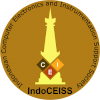Developing Smart City 5.0 Framework To Produce Competency
Abstract
Abstract - Smart cities are essential things that must be applied in the face of globalization and competition. In smart city 5.0, three important things discussed are human resource development, smart marketing, and information technology. These three things cannot be separated from each other because they are related. Furthermore, the smart city 5.0 article is a development from the previous article, namely smart city 1.0-3.0. Smart City 5.0 provides four important formulas for developing a smart city and a framework to guide its implementation. The four formulas and the resulting framework will develop in the next article, namely intelligent intelligence. It will continue to make prototypes and smart city intelligence applications. The result of this article is a framework that is a concept and strategy in developing a smart region that is part of a smart city. This article is still under development and research will continue. Furthermore, the development of this research will certainly require several more stages in reaching the top of the research, namely a big picture of a smart city and performance measurement for each process contained in a smart city. Therefore, it takes the right steps and formulas to produce a smart city 5.0 framework
Keywords - Smart city, Human resource, Marketing, Technology, Innovation
Full Text:
PDFReferences
I. Gamayanto, Analysis of {Wollongong} city council using 7s ’ s of galliers and {Sutherland} methods. Comptech Journal, 205, 205–213, 2017.
I. Gamayanto, Analysis of Wollongong City Council Using 7S ’ S of Galliers and Sutherland Methods. Comptech Journal, 205, 205–213, 2017.
H. Chourabi, J. R. Gil-garcia, T. A. Pardo, H. J. Scholl, S. Walker, and K. Nahon, Understanding Smart Cities : A n Integrative Framework. Hawaii International Conference on System Sciences Understanding, 2012.
M. Thite, “Smart cities : Implications of urban planning for human resource development, Human Resource Development International Smart cities : implications of urban planning for human resource development,” Hum. Resour. Dev. Int., 2011.
S. R. Torbatjoo, “Impact of human resources measures on organizational ambidexterity of smart city projects,” Int. J. Hum. Cap. Urban Manag., vol. 3, no. 4, 2018.
S. Joss et al., “The Smart City as Global Discourse : Storylines and Critical Junctures across 27 cities,” J. Urban Technol., vol. 26, no. 1, 2018.
H. Xu and X. Geng, smart cities People-Centric Service Intelligence for Smart Cities. 135– 152, 2019.
M. Armstrong and D. Brown, Strategic Human Resource Management: Back to the future? A literature review Chartered Institute of Personnel and Development (CIPD). Berger, R, 2019.
R. Kitchin, P. Cardullo, and C. Di Feliciantonio, Citizenship, Justice, and the Right to the Smart City. Citizenship, Justice, and the Right to the Smart City.
{KPMG}, 2015.
N. W. Deriani and T. M. Kusuma, “The level of adoption of E-commerce by small-medium scale industries,” Int. J. Hum. Cap. Urban Manag., vol. 4, no. 2, 2019.
D. Acemoglu and J. A. Robinson, “Rents and economic development: the perspective of Why Nations Fail,” Public Choice, vol. 181, no. 1, 2019.
M. Mirzapour, S. S. Toutian, A. Mehrara, and S. Khorrampour, “The strategic role of human resource management in crisis management considering the mediating role of organizational culture,” Int. J. Hum. Cap. Urban Manag., vol. 4, no. 1, 2019.
L. Lalicic and I. Önder, “Residents’ involvement in urban tourism planning: Opportunities from a smart city perspective,” Sustain., vol. 10, no. 6, 2018.
H. W. Lee, J. Pak, S. Kim, and L. Z. Li, “Effects of Human Resource Management Systems on Employee Proactivity and Group Innovation,” J. Manage., vol. 45, no. 2, 2 019.
I. Gamayanto, “Pengembangan Mentoring Management Dalam Menghasilkan High Quality Human Resource Di Tingkat Universitas Dalam Menghadapi Masyarakat Ekonomi Asean (Mea) Dengan Menggunakan Konsep Kiyosaki Dan Blanchard Abcd Trust Methods-Hsova,” J. Manaj., vol. 13, no. 2, pp. 158–178, 2016.
D. Acemoglu and J. A. Robinson, “Rents and economic development: the perspective of {Why} {Nations} {Fail},” Public Choice, vol. 2, no. 1, 2017.
K. Kashima and Y. Morita, “Conceptualizing Smart Tourism of Japan: A Case Study Of Smart Tourism Design on China And Thailand,” Int. J. Manag. Appl. Sci., vol. 3, no. 3, 2017.
A. JASROTIA and A. GANGOTIA, “Smart Cities To Smart Tourism Destinations: a Review Paper,” J. Tour. Intell. Smartness, vol. 1, no. 1, 2018.
I. Bureau and T., “Hong Kong Smart City Blueprint,” in Smart City Consortium, 2017.
F. A. Joshua, “Assessment of the Role and Functions of Human Resources Department in Small and Medium Scale Enterprise Companies in Ile – Ife,” Osun. J. Hum. Resour. Manag., vol. 7, no. 2, 2019.
D. L. Deadrick and D. L. Stone, “Human resource management: Past, present, and future,” Hum. Resour. Manag. Rev., vol. 24, no. 3, 2014.
T. G. W. University, GW Human Resources Strategic Plan 2017-2021. GW Human Resources Strategic Plan 2017-2021.
L. Zhang, X. Guo, Z. Lei, and M. K. Lim, “Social network analysis of sustainable human resource management from the employee training perspective,” Sustain., vol. 11, no. 2, 2019.
K. S. Kim and T. H. Shin, “Additive effects of performance- and commitment-oriented human resource management systems on organizational outcomes,” Sustain., vol. 11, no. 6, 2019.
M. T. Latkovikj and M. B. Popovska, Competency Framework for Human Resource (Issue December 2015). 2019.
A. Sinclair and P. White, A Strategic role for HR: is it a competence issue? Taxation in Australia. 16, 2015.
S. Long, C. F. C., C. A. G., U., O. Kowang, and T., “The Relationship between HR Competencies and Organizational Performance in the Banking Sector in Nigeria,” Int. J. Hum. Resour. Stud., vol. 8, no. 217., 2018.
M. Peris-ortiz and D. R. Bennett, Sustainable Smart Cities. Springer, January, 2017.
DOI: https://doi.org/10.33633/jais.v5i1.4228
Article Metrics
Abstract view : 339 timesPDF - 229 times
Refbacks
- There are currently no refbacks.
Journal of Applied Intelligent System (e-ISSN : 2502-9401, p-ISSN : 2503-0493) is published by Department of Informatics Universitas Dian Nuswantoro Semarang and IndoCEISS.


Journal of Applied Intelligent System indexed by :
This journal is under licensed of Creative Commons Attribution 4.0 International License.

_.png)






